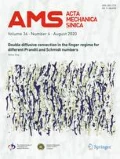Abstract
Lesion of ossicular chain is a common ear disease impairing the sense of hearing. A comprehensive numerical model of human ear can provide better understanding of sound transmission. In this study, we propose a three-dimensional finite element model of human ear that incorporates the canal, tympanic membrane, ossicular bones, middle ear suspensory ligaments/muscles, middle ear cavity and inner ear fluid. Numerical analysis is conducted and employed to predict the effects of middle ear cavity, malleus handle defect, hypoplasia of the long process of incus, and stapedial crus defect on sound transmission. The present finite element model is shown to be reasonable in predicting the ossicular mechanics of human ear.
Similar content being viewed by others
References
Iurato S., Quaranta A. (1999) Malleus-handle fracture: historical review and three new cases. Am. J. Otol. 20: 19–25
Park K., Choung Y.-H., Shin Y.R. (2007) Conductive deafness with normal eardrum absence of the long process of the incus. Acta Otolaryngol. 127: 816–820
Gomes G., Felix F., Tomita S. (2005) Improvements of bone conduction after stapes surgery. Otolaryngol. Head Neck Surg. 133: 240
Funnell W.R.J., Laszlo C.A. (1978) Modeling of the cat eardrum as a thin shell using the finite-element method. J Acoust. Soc. Am. 63: 1461–1467
Wada H., Metoki T. (1992) Analysis of dynamic behavior of human middle ear using a finite method. J. Acoust. Soc. Am. 92: 3157– 3168
Sun Q., Gan R.Z., Chang K.-H., Dormer K.J. (2002) Computer-integrated finite element modeling of human middle ear. Biomech. Model. Mechanobiol. 1: 109–122
Gan R.Z., Feng B., Sun Q. (2004) Three-dimensional finite element modeling of human ear for sound transmission. Ann. Biomed. Eng. 32: 847–859
Lee C.F., Chen J.H., Chou Y.F. (2007) Optimal graft thickness for different sizes of tympanic membrane perforation in cartilage myringoplasty a finite element analysis. Laryngoscope 117: 725–730
Liu Y.X., Li S., Sun X.Z. (2008) Numerical modeling of human ear for sound transmission. Chin. J. Theor. Appl. Mech. 40: 107–113 (in Chinese)
Voss S.E., Rosowski J.J., Merchant S.N., Peake W.T. (2000) Acoustic respones of the human middle ear. Hear. Res. 150: 43–69
Williams K.R., Lesser T.H. (1990) A finite element analysis of the natural frequencies of vibration of the human tympanic membrane. Part I. Br. J. Audiol. 24: 319–327
Beer, H.J., Bornitz, M., Drescher, J.: Finite element modeling of the human eardrum and applications. In: Huttenbrink, K.B. (ed.) Middle Ear Mechanics in Research and Otosurgery, pp. 40–47. Dresden University of Technology, Dresden (1996)
Kirikae I. (1960) The Structure and Function of the Middle Ear. University of Tokyo Press, Tokyo
Speirs A.D., Hotz M.A., Oxland T.R. (1999) Biomechanical properties of sterilized human auditory ossicles. J. Biomech. 32: 485– 491
Herrmann, G., Liebowitz, H.: Mechanics of bone fractures. In: Liebowitz, H. (ed.) Fracture: an Advanced Treatise, pp. 772–840. Academic Press, New York (1972)
Wada, H., Koike, T., Kobayashi, T.: Three-dimensional finite-element method (FEM) analysis of the human middle ear. In: Huttenbrink, K.B. (ed.) Middle Ear Mechanics in Research and Otosurgery. pp. 76–80. Dresden University of Technology, Dresden (1996)
Koike T., Wada H., Kobayashi T. (2002) Modeling of the human middle ear using the finite-element method. J. Acoust. Soc. Am. 111: 1306–1317
Gan R.Z., Sun Q., Feng B., Wood M.W. (2006) Acoustic–structural coupled finite element analysis for sound transmission in human ear-pressure distributions. Med. Eng. Phys. 28: 395–404
Mehta R.P., Rosowski J.J., Voss S.E. (2006) Determinants of hearing loss in perforations of the tympanic membrane. Otol. Neurotol. 27: 136–143
Author information
Authors and Affiliations
Corresponding author
Additional information
The project was supported by the National Natural Science Foundation of China (10472025, 10672036, and 10872043).
Rights and permissions
About this article
Cite this article
Liu, Y., Li, S. & Sun, X. Numerical analysis of ossicular chain lesion of human ear. Acta Mech Sin 25, 241–247 (2009). https://doi.org/10.1007/s10409-008-0206-6
Received:
Revised:
Accepted:
Published:
Issue Date:
DOI: https://doi.org/10.1007/s10409-008-0206-6




